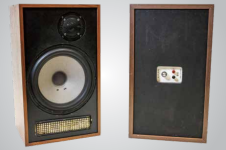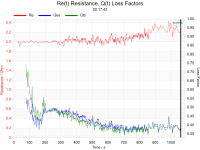What was the impedance range for this 15" subwoofer during the LSI run?Looks like LPM small signal voltage was .05, I always start my LSI runs for subwoofers at 1v, and peak voltage for the run was 20.5.
The story of Symmetric Drive is the story of Scan-Speak.
But the story of Scan-Speak cannot be told without first introducing David Hafler, the American who founded Dynaco in 1954. He's probably best remembered for selling vacuum tube stereo amplifiers - most notably the Stereo 70 (1959) or offering them as kits (Dynakit) for hobbyists to assemble at home. Both were major commercial successes.
During the golden age of hi-fi, many startups emerged from employees departing companies like B&O and KEF.
One such ex-B&O employee founded Audio Dyne in 1965 to import Dynaco amplifiers into the European market. By 1967, with Hafler’s support, the company became ScanDyna. The plan: ScanDyna would manufacture cabinets, source drivers from SEAS, assemble the products in Denmark, and export complete systems for the booming American hi-fi market.
The first product was the Dynaco A-25 (1968), featuring a SEAS 10″ woofer with an innovative rubber surround (rare at the time) and one of the earliest soft dome tweeters — the SEAS H87, a 1.5″ design.

size: 50 x 29 x 25 (HxWxD)
Seeking a second supplier, Hafler met the enterprising Ejvind Skaaning — a former Ford mechanic, scooter business owner, and founder of Quality Sound Recordings. Skaaning built a prototype, won Hafler’s confidence, and began supplying complete speakers using SEAS drivers.
The A-25 became a massive commercial success. SEAS and QSR both benefitted, but SEAS was unhappy having a competitor (QSR) supplying Dynaco. When SEAS engineer Mogens Hvass collaborated with QSR to develop a 1.5″ D38 soft dome tweeter, SEAS fired him. Skaaning hired him immediately. In February 1970, Skaaning converted QSR into Scan-Speak, later hiring Ragnar Lian — also formerly of SEAS. Together, Mogens and Ragnar were once again developing drivers — this time under the Scan-Speak banner.
Meanwhile, the A-25’s popularity soared: Stereophile gave it a favorable review in 1969, and Consumer Reports awarded it a “Best Buy” in 1970. Over its lifetime, the A-25 sold more than one million units worldwide — a remarkable figure, even by today’s standards, for a true middle-class hi-fi loudspeaker.
In December 1973, Ragnar Lian was granted a patent for a copper-covered pole piece — or “copper cap” — designed to make voice coil inductance versus excursion Le(x) symmetric. Lian personally held and maintained the patent, collecting royalties from Scan-Speak. When Philips challenged the patent in court, Lian successfully defended it — despite Philips having released products that same year (like the Philips Studio Monitor 8 and Sonab OA5) featuring the 9710, an 8″ full-range driver with a copper-covered pole:

When the 20-year patent expired in 1993, Lian revised the design: instead of a full sleeve, he split the copper into three rings — calling it SD-1. It was more economical (read: cheaper) than the original SD.
Examples of SD
13M/4535, 13M/8636, 13M/8640, 21W/8554, 18W/8542, D2905/9700, D2904/9800, D3806/8200,
Examples of SD-1
21W/8555, 18W/8545, Scan-Speak Revelator line-up etc
The Skaaning Legacy
In 1975, Skaaning co-founded RMS (Richter, Mordechai & Skaaning) with Meir Mordechai and Gerhard Richter.
In 1976, Mordechai took over and converted it into Morel.
Skaaning left the following year and, once again with Richter, founded Dynaudio in 1977. Later pushed out, Skaaning went independent, founding a new company with his son. In 1990, this was renamed Audio Technology by Skaaning.
Skaaning, the man, was nothing if not persistent.
Today, copper sleeves live on in numerous lines
Have I missed any? Any errors? Please let me know
But the story of Scan-Speak cannot be told without first introducing David Hafler, the American who founded Dynaco in 1954. He's probably best remembered for selling vacuum tube stereo amplifiers - most notably the Stereo 70 (1959) or offering them as kits (Dynakit) for hobbyists to assemble at home. Both were major commercial successes.
During the golden age of hi-fi, many startups emerged from employees departing companies like B&O and KEF.
One such ex-B&O employee founded Audio Dyne in 1965 to import Dynaco amplifiers into the European market. By 1967, with Hafler’s support, the company became ScanDyna. The plan: ScanDyna would manufacture cabinets, source drivers from SEAS, assemble the products in Denmark, and export complete systems for the booming American hi-fi market.
The first product was the Dynaco A-25 (1968), featuring a SEAS 10″ woofer with an innovative rubber surround (rare at the time) and one of the earliest soft dome tweeters — the SEAS H87, a 1.5″ design.

size: 50 x 29 x 25 (HxWxD)
Seeking a second supplier, Hafler met the enterprising Ejvind Skaaning — a former Ford mechanic, scooter business owner, and founder of Quality Sound Recordings. Skaaning built a prototype, won Hafler’s confidence, and began supplying complete speakers using SEAS drivers.
The A-25 became a massive commercial success. SEAS and QSR both benefitted, but SEAS was unhappy having a competitor (QSR) supplying Dynaco. When SEAS engineer Mogens Hvass collaborated with QSR to develop a 1.5″ D38 soft dome tweeter, SEAS fired him. Skaaning hired him immediately. In February 1970, Skaaning converted QSR into Scan-Speak, later hiring Ragnar Lian — also formerly of SEAS. Together, Mogens and Ragnar were once again developing drivers — this time under the Scan-Speak banner.
Meanwhile, the A-25’s popularity soared: Stereophile gave it a favorable review in 1969, and Consumer Reports awarded it a “Best Buy” in 1970. Over its lifetime, the A-25 sold more than one million units worldwide — a remarkable figure, even by today’s standards, for a true middle-class hi-fi loudspeaker.
(US$160 per pair in 1969 ≈ US$2000 in 2025)
***
The Evolution of Symmetric DriveIn December 1973, Ragnar Lian was granted a patent for a copper-covered pole piece — or “copper cap” — designed to make voice coil inductance versus excursion Le(x) symmetric. Lian personally held and maintained the patent, collecting royalties from Scan-Speak. When Philips challenged the patent in court, Lian successfully defended it — despite Philips having released products that same year (like the Philips Studio Monitor 8 and Sonab OA5) featuring the 9710, an 8″ full-range driver with a copper-covered pole:
When the 20-year patent expired in 1993, Lian revised the design: instead of a full sleeve, he split the copper into three rings — calling it SD-1. It was more economical (read: cheaper) than the original SD.
Examples of SD
13M/4535, 13M/8636, 13M/8640, 21W/8554, 18W/8542, D2905/9700, D2904/9800, D3806/8200,
Examples of SD-1
21W/8555, 18W/8545, Scan-Speak Revelator line-up etc
***
The Skaaning Legacy
In 1975, Skaaning co-founded RMS (Richter, Mordechai & Skaaning) with Meir Mordechai and Gerhard Richter.
In 1976, Mordechai took over and converted it into Morel.
Skaaning left the following year and, once again with Richter, founded Dynaudio in 1977. Later pushed out, Skaaning went independent, founding a new company with his son. In 1990, this was renamed Audio Technology by Skaaning.
Skaaning, the man, was nothing if not persistent.
***
The legacy of copper sleevesToday, copper sleeves live on in numerous lines
- Audio Technology - units with SD suffix
- Peerless selected units in HDS range (e.g., 850489, 850467) and HDS Exclusive line
- Vifa NE → later Peerless by Tymphany NE, PLS, and select TC/TG models
- Wavecor Balanced Drive series
- SB Acoustics — SB15 and SB17 (copper sleeves with ferrite motors) and SB20FRPC30, Satori line (copper sleeves with neodymium motors) except WO24 lines
- SEAS — Excel line since 2019, starting with graphene anti-rust coating and copper sleeves: (W16NX003, W12CY004, W18EX003, W19NX001, and most recently W19NX004), as well Design → later Extreme line
- B&C — denoted as “shorting copper cap”
- Celestion — denoted as “copper sleeved pole”
- Faital Pro — denoted as “copper cap”
- Purifi
References:
https://www.cfuttrup.com/history/index.html
Further reading:
Danish Loudspeakers - 100 Years (1915-2015)
https://www.cfuttrup.com/history/index.html
Further reading:
Danish Loudspeakers - 100 Years (1915-2015)
Have I missed any? Any errors? Please let me know
Last edited:
This was an AMAZING writeup. Thank you so much for this. Turns out I have just selected four SB15 for a 2.5way. Cool that they have this tech in them.The story of Symmetric Drive is the story of Scan-Speak.
manufacturers?Have I missed any?
Acoustic Elegancce.
A&D audio. no mention in product sheets. fx: MD8E260, K12G510, D15G610 etc.
B&W midranges FST, Tweeters(silver), and a few bass units.
Beyma- FR and mid drivers fx: 8P300FE, Pro8Q300ND etc.
Ciare- Midrange/fullrange a few of them.
Davis acoustics 20DE8, or OEM.
Dayton audio. fx. Epique.
Eighteensound. fx. 12NMB420, 15MB1000, 8m400f, copper sleeve etc.
GT sound japan.
JBL woofers and HF.
Kartesian. In a lot of they're selection.
Lavoce - Midrange MAN 06x fx.
Morel SCW 636 (according to they're marketing).
Punktkilde : ASDWD0001-0800
PHL audio, 900x?
Precision Devices fx 1
RCF have a few older designs L15-554K fx.
Redcatt. In HF, and woofers fx XR series 18", 21" etc.
SB audience WMNxxxD line.
VUE audiotech, 4" kevlar midranges.
Visaton. fx Ti100
